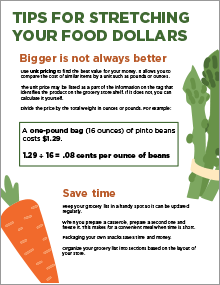Editor’s note
You can read this publication on this page or download the PDF.
See the companion publication N1028, Eating on a Budget Poster.

This handout provides tips on stretching your food dollars. It discusses unit pricing, how to get the most out of the food you buy, and other ways to save money on your food budget.
The printed version is a two-page 8.5-by-11 inch handout.
See handout content below.
Tips for Stretching Your Food Dollars

Bigger is not always better
Use Unit pricing to find the best value for your money. It allows you to compare the cost of similar items by a unit such as pounds or ounces.
The unit price may be listed as a part of the information on the tag that identifies the product on the grocery store shelf. If it does not, you can calculate it yourself.
Divide the price by the total weight in ounces or pounds. For example:

Save time
Keep your grocery list in a handy spot so it can be updated regularly.
When you prepare a casserole, prepare a second one and freeze it. This makes for a convenient meal when time is short.
Packaging your own snacks saves time and money.
Organize your grocery list into sections based on the layout of your store.

Food that gets thrown out is money lost
Put food away promptly after meals.
Freeze leftover casseroles in lunch-sized portions.
Freeze meat that won’t be used by the use by date.
Use all edible parts of broccoli: Serve the florets steamed and use the stalks for soup.
Rotate foods in the refrigerator and freezer to make it easier to follow the first in, first out principle.

Other ways to save money
Use vegetables and whole-grain pasta to stretch meals and boost nutrition.
Plant a garden. (Food can be grown in small spaces.)
Beware of convenience stores and vending machines.
Carry a water bottle. It can be filled for free.
Stock up on frequently used items when they are on sale.

Get the most value for your food dollar
Foods high in added sugar and saturated fat such as cookies and donuts have fewer nutrients than fruits, vegetables, and whole grains. Fruits, vegetables, and whole grains are packed with nutrients and fiber. Fiber helps to fill you up and keep hunger away.